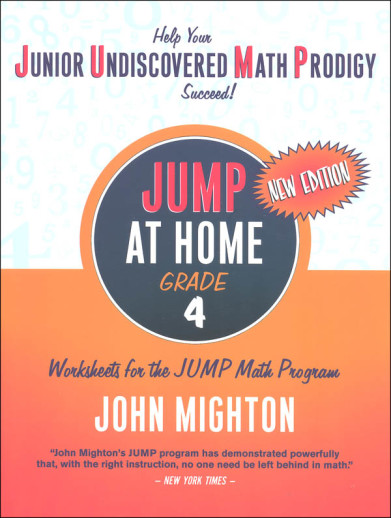We use cookies to make your experience better. To comply with the new e-Privacy directive, we need to ask for your consent to set the cookies. Learn more.
JUMP at Home Grade 4: Worksheets for the JUMP Math Program
John Mighton's JUMP program is changing the way math is taught, and his powerful math workbooks give children the tools they need to master this crucial subject. The key is a step-by-step teaching method that isolates and describes concepts so clearly that anyone can understand them: students build on their successes, becoming proficient at solving problems with confidence and enthusiasm. Now, parents and caregivers can bring the JUMP program home. These workbooks follow the current student worksheets used by JUMP tutors and classroom teachers, including: an introduction for parents and caregivers that clearly explains the thinking behind the program and provides hours of activities, worksheets carefully designed to enable children to move from one success to the next, a glossary of math terms, and a selected answer key.
You might call these worksheet books "kissing cousins" to the JUMP Math program. Employing the same mastery and incremental methodology, emphasizing continuous assessment, these worksheets are designed to be used at home (as the name implies) in a tutoring situation. In fact, there is even some introductory information providing help for tutors. Also, rather than being dependent on online teaching resources, these books are stand-alones providing clear explanations of math concepts for both students and tutors. Some of the JUMP Math extra resources mental math and games are provided in hard copy in these workbooks as well. Answer keys are available for grades 3-8, but only on the Canadian "side" of the Jump Math website. You will have to set up an account to access the answer keys. [www.jumpmath.org>Canada>Publications>Answer Keys>Answer Key for AP Book __ (scroll down to Jump at Home Answer Key).]
It should be noted that these sets of worksheets do NOT include all the content of the JUMP Math program. There are significant strands that are missing altogether (geometry, statistics and advanced probability). Although there is specific topical content from the JUMP Math program repeated in the worksheets, the scope and sequence of the two programs are not identical. Comparing the tables of contents on our website from each series will give you an idea of the differences. Roughly, it appears that the JUMP at Home worksheets trail behind the JUMP Math levels. You might think of JUMP at Home worksheets as providing review of last year's content and preparing the student for the next level. For instance, JUMP at Home 7 would review JUMP Math 5 & 6, really only covering content through JUMP Math Book 6.1. 175 200 pgs, pb. ~ Janice
| Product Format: | Paperback |
|---|---|
| Grade: | 4 |
| Brand: | House of Anansi Press |
| Author: | John Mighton |
| ISBN: | 9780887849770 |
| Length in Inches: | 10.875 |
| Width in Inches: | 8.375 |
| Height in Inches: | 0.5 |
| Weight in Pounds: | 1.15 |
Be the first to review this item

